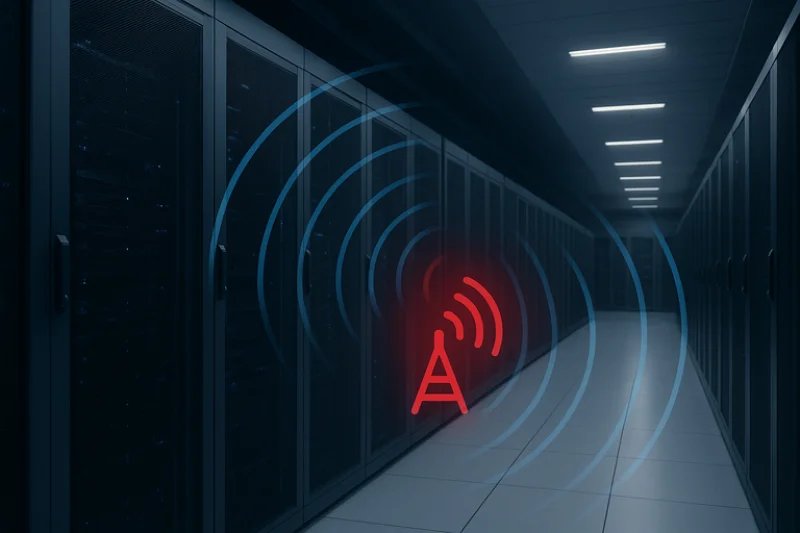
The Expanding Countersurveillance Challenge
Modern surveillance threats are increasingly wireless. Hidden transmitters, covert cellular devices, and Bluetooth-based microphones can silently exfiltrate information from corporate offices, data centers, and government facilities. Many of these tools operate on the same frequencies as legitimate systems, making them indistinguishable to traditional IT monitoring solutions.
Organizations face an additional challenge from unauthorized or unapproved wireless devices. Employees and contractors may unintentionally introduce personal hotspots, Bluetooth accessories, or IoT gadgets that violate security policy. These devices can create new attack surfaces, extend network reach beyond secure boundaries, or broadcast sensitive data without traditional network defenses detecting them.
Traditional Technical Surveillance Countermeasures (TSCM) methods rely on handheld spectrum analyzers, spectral correlators, nonlinear junction detectors, and more to locate transmitters during scheduled sweeps. While useful for periodic checks, these methods cannot provide continuous awareness across large or complex environments. A persistent, passive monitoring capability is now essential for maintaining real-time insight into all wireless activity.
The Operational Context: From Boardrooms to Data Centers
Countersurveillance activities today must extend beyond conference rooms and secure offices. Data centers, in particular, represent a critical and often overlooked target. These facilities house high-value systems and proprietary intellectual property, typically accommodating multiple tenants in tight proximity. Even a single unauthorized wireless transmitter, whether malicious or accidental, can introduce unacceptable risk.
Continuous wireless visibility allows organizations to:
- Detect unapproved or rogue wireless devices in secure or restricted zones.
- Identify short-burst transmissions consistent with covert eavesdropping tools.
- Track cellular modems or Wi-Fi adapters embedded in IoT hardware.
- Monitor contractor or vendor activity to confirm that they do not introduce unverified wireless devices.
- Maintain a documented record of all RF activity for compliance and auditing.
For environments such as SCIFs, research labs, and data centers, persistent RF awareness has become a foundational control, equal in importance to physical access management and network segmentation.
Establishing Wireless Governance and Policy Enforcement
A comprehensive countersurveillance strategy must address both policy and technology. Security teams first define what constitutes approved wireless activity, then continuously monitor for deviations from that baseline. This governance framework includes:
- RF Policy Definition: Establishing clear rules for permitted wireless technologies (Wi-Fi, Bluetooth, LTE/5G) and frequency ranges.
- Device Registration: Maintaining an up-to-date inventory of authorized emitters and their expected behavior.
- Continuous Monitoring: Using passive sensors to detect new or unknown transmitters in real time.
- Alerting and Investigation: Flagging devices that operate outside policy parameters or transmit in sensitive areas.
- Audit and Reporting: Capturing historical data to demonstrate compliance with standards such as NIST 800-53, ISO 27001, or CMMC.
Without automated detection, these steps are impractical at scale, particularly in facilities where hundreds of wireless signals may be active simultaneously.
The Role of Passive RF Monitoring
Passive RF monitoring enables the detection and analysis of all wireless activity without emitting any signals. By continuously observing the RF environment, it identifies transmitters, characterizes their protocols, and recognizes anomalies that deviate from established baselines.
This approach enables organizations to:
- Reveal all wireless devices operating within range, including unauthorized or concealed ones.
- Operate covertly, without alerting potential adversaries or interfering with regular communications.
- Maintain continuous situational awareness, even in “no-transmit” or “RF-quiet” zones.
Passive monitoring extends beyond reactive detection. It forms the basis for proactive wireless governance and long-term countersurveillance readiness.
Bastille: Continuous Passive Countersurveillance
Bastille provides a purpose-built, 100% passive system for continuous RF monitoring across frequencies from 100 MHz to 7.125 GHz. This coverage spans Wi-Fi, Bluetooth, BLE, Zigbee, LTE, and 5G, as well as nonstandard or proprietary transmitters often used in covert communications.
Bastille continuously identifies, classifies, and locates every emitter within range. When an unauthorized or unapproved wireless device begins transmitting, the system detects the signal characteristics and determines its location using Bastille Sensors placed strategically throughout the facility. This localization enables rapid identification and removal of rogue or hidden devices.
Data Center and Enterprise Applications
- Unauthorized Device Detection: Identify personal hotspots, rogue access points, or unapproved IoT sensors operating near critical systems.
- Compliance and Audit Readiness: Maintain a documented record of all wireless activity to support NIST 800-53, ISO 27001, and CMMC requirements.
- Operational Assurance: Verify that sensitive areas remain “RF-quiet” and free from active transmitters.
- Change Detection: Detect newly introduced or previously unseen wireless devices in real time.
Security Operations Integration
Bastille integrates directly with existing SOC and SIEM tools, providing metadata, device history, and RF fingerprint data for correlation with physical access logs or video surveillance. This unified view of the wireless spectrum helps analysts rapidly triage and respond to both malicious and accidental policy violations.
Conclusion
Countersurveillance is no longer limited to sweep-based inspections or manual RF checks. In environments where unauthorized and unapproved wireless devices can appear at any moment, continuous visibility has become a strategic necessity.
Passive RF monitoring provides the awareness necessary to detect covert transmitters, enforce wireless policies, and safeguard sensitive information. Bastille extends this capability by offering a scalable, passive platform that continuously observes the entire wireless spectrum, detecting, classifying, and locating every emitter to help organizations maintain complete control over their wireless environment.




